#Azovstal steel plant
Explore tagged Tumblr posts
Text

Evening railway station in Kyiv, Ukraine on June 12, 2024. (Danylo Pavlov / The Kyiv Independent)
Unexpected tears
A chance encounter on a train initially brought tears to the eyes of Kyiv resident Olha Hrianyk, and led her to experience grief she thought she would never endure again. Hrianyk, 63, and her husband were traveling from Chernivtsi to the capital last May when a tall young man entered their compartment. The couple noticed a very familiar and cherished unit badge on his backpack. "'Are you from the Azov brigade?' My husband asked," Hrianyk recalls. "He said: 'How do you know?'" "I told him that our son was an Azov fighter." Hrianyk's son Oleksandr helped liberate Kyiv Oblast in the early months of the full-scale war. He was then transferred to defend Mariupol, ending up at the Azovstal steel plant, the last Ukrainian stronghold in the city, where he was killed on May 8, 2022. He was 29. Vladyslav, the young man they accidentally met on the train, was undergoing training to join Azov. Some of his commanders had known Hrianyk’s son Oleksandr well: "He told us it was a great honor for him to meet us," Hrianyk says. The elderly couple and the young soldier talked until late at night, opening their hearts and sharing stories about military service and the war: "I looked at him thinking, 'Son, you’re so bright, you're so proud to be there (in Azov). What amazing young people we have,'" says Hrianyk. "In that brief time, that child became like family to me." They shared phone numbers and kept in touch with Vladyslav while he was undergoing military training in Kyiv, often inviting him over for dinner or simply to rest after being on duty. One day last September, Vladyslav's mother suddenly called Hrianyk, expressing relief at finally contacting the couple her son had accidentally met on the train and had told her a lot about. But then she delivered some heartbreaking news: Vladyslav had been killed in combat near Bakhmut. He was only 19. "We printed his portrait and put it at the fallen soldiers’ memorial (next to the St. Michael’s Cathedral in Kyiv). (The portrait of) our Oleksandr is there too," Hrianyk says. “Now, as we come there to see our Sasha, we come to see Vlad, too.”
Source: From strangers to friends: How Ukrainians meet and bond during wartime train travel
#Ukraine#trains#train travel#excerpt#article in link#Ukrzaliznytsia#death#war#russia is a terrorist state
21 notes
·
View notes
Text

Russian troops fire from a tank during fighting near the Azovstal steel plant in the southern port city of Mariupol, Ukraine. 5 May 2022.
24 notes
·
View notes
Text
With Russia’s full-scale invasion now in its third year, destruction and reconstruction are still proceeding simultaneously in Ukraine. Be that as it may, Kyiv has been laying out big plans for the country’s post-war recovery, which will require more than just international investment. In an article originally written for Kit, journalist and researcher Konstantin Skorkin looks to the future and examines the key stumbling blocks for rebuilding Ukraine that are already emerging through the fog of war. The following translation has been abridged for length and clarity.
The following is an abridged translation that appeared in The Beet, a weekly email dispatch from Meduza covering Central and Eastern Europe, the Caucasus, and Central Asia. Sign up here to get the next issue delivered directly to your inbox.
Even if Russia’s invasion ended today, according to the most conservative estimates, Ukraine’s reconstruction and recovery would cost around $500 billion and take at least 10 years. Kyiv has already taken the first steps on this long road, establishing a dedicated office for assessing the full extent of the damage, laying out a recovery plan, and securing tens of billions of dollars in international support for reconstruction.
According to Bloomberg, Ukraine’s reconstruction could be “the biggest investment opportunity since at least World War II.” And companies worldwide are already jockeying for their piece of the pie.
But rebuilding Ukraine will take more than cash. The war has dealt a terrible blow to the country’s human capital, from lives lost on the battlefield to civilians forced to flee abroad, many never to return. And bringing large numbers of people back to Ukraine is much harder than securing large amounts of funding.
The damages
Russia’s aggression has caused more than $150 billion in direct damage to Ukraine. The country’s GDP fell by 30 percent in 2022 and grew only 5 percent in 2023. The World Bank estimates the cost of reconstruction and recovery at $486 billion, while European Investment Bank chief Werner Hoyer predicts that Ukraine may require as much as $1.1 trillion in outside assistance to rebuild.
Ukraine’s main export sectors, agriculture and metallurgy, have been hit especially hard. According to estimates from the Kyiv School of Economics, the agricultural sector has suffered more than $80 billion in damages and losses, with Russia occupying fertile areas in Ukraine’s south and east, and shelling and landmines rendering farmland in the north unusable. Ukraine’s richest oligarch, Rinat Akhmetov, has seen his agricultural holding HarvEast lose 70 percent of its arable land to Russian occupation. And one of Ukraine’s leading grain exporters, Nibulon, estimates its losses due to the war at more than $400 million. A Russian missile strike killed the company’s founder, grain tycoon Oleksiy Vadatursky, in July 2022.

The Azovstal steel plant in Mariupol. May 10, 2022.
AFP / Scanpix / LETA
The Ukrainian steel industry, meanwhile, has seen two of its biggest producers turned to rubble: the Azovstal and the Ilyich Iron and Steel Works in occupied Mariupol. These two factories, which once accounted for 40 percent of Ukraine’s steel production, made up the core of Akhmetov’s Metinvest Group. In June 2023, the company estimated its total damages from the war at more than $3.5 billion. Two other major steelworks — Akhmetov’s Zaporizhstal and ArcelorMittal Kryvyi Rih (formerly Kryvorizhstal) — are operating at half capacity, while the Nikopol Ferroalloy Plant, located in the Dnipropetrovsk region, has suspended work altogether.
Ukraine’s energy sector is also suffering, mainly due to sustained Russian attacks on its power plants. Last month, President Volodymyr Zelensky said that Russia had destroyed “almost all” of Ukraine’s thermal power generation. And since Ukraine’s green energy infrastructure is concentrated in the south, Russian occupation has knocked out of commission 90 percent of its wind energy and half its solar power.
For Ukrainians, the damage to power plants and the electric grid means living with rolling power and heating outages. Moreover, repaired energy infrastructure risks getting hit again — like Kharkiv’s Thermal Power Plant No. 5. After being damaged in a missile strike in September 2022, the power plant came back online this March only to suffer a devastating attack two weeks later. Repair work is expected to take at least a year.
The Ukrainian authorities estimate that the country will need about $15 billion for immediate reconstruction and recovery efforts in 2024 alone. And Kyiv’s post-war Recovery Plan will require $750 billion over 10 years. Two-thirds of this funding is expected to come from Ukraine’s partners, with the remainder from private investors and confiscated assets from Russia and Russian oligarchs.
In July 2022, 40 countries signed the Lugano Declaration, pledging to support Ukraine’s post-war recovery. According to Bloomberg, the European Union plans to “contribute the bulk” of this financial assistance, which could exceed 500 billion euros ($523 billion). E.U. countries are also kicking in individually: Finland’s Ukraine Investment Facility, for example, plans to fund 50 million euros ($54 million) worth of projects in 2025–2026. Other European countries — including Austria, Sweden, the Netherlands, Italy, Poland, and Germany — have committed to helping rebuild specific Ukrainian regions.

An aerial view of the destroyed engine room of the Trypilska TPP, one of Ukraine’s largest thermal power plants in the Kyiv region, following a Russian missile attack. April 11, 2024.
Kostiantyn Liberov / Libkos / Getty Images
The United States Agency for International Development (USAID) has provided more than $23 billion in humanitarian, economic, and development assistance to Ukraine since the start of the full-scale invasion. Private companies are investing in Ukraine’s reconstruction, as well. In January, Kyiv announced that it was creating a Ukraine reconstruction bank with help from JPMorgan Chase and BlackRock. At the time, Zelensky’s deputy chief of staff Rostyslav Shurma said the fund could launch in five or six months with close to $1 billion in committed capital.
Theoretically, reparations and confiscated assets from Russia could also be important in rebuilding Ukraine. However, this is easier said than done. The former will hinge on when (and, more importantly, how) the war ends, while the latter is the subject of ongoing policy debate. Western countries have frozen around $300 billion in sovereign Russian assets since February 2022. The U.S. is still developing legislation that would allow for seizing the $5–$8 billion under its jurisdiction, while the E.U. greenlit using the profits from frozen Russian assets to help Ukraine just this week.
The people
The war has dealt perhaps the most terrible blow of all to Ukraine’s human potential. On top of causing tens of thousands of military and civilian losses, Russia’s invasion prompted one of the 21st century’s largest refugee waves. According to the United Nations, more than 6.4 million people have left Ukraine since February 2022. Some were forced to flee to Russia, but most found refuge in Europe.
More than two years on, many of these refugees have adapted to life in another country, and a significant proportion don’t plan to return home. A recent study by the U.N. Refugee Agency found that in the last year, the number of refugees who hope to go back to Ukraine has dropped from 77 percent to 65 percent. According to data from the Kyiv-based Center for Economic Strategy, between 1.3 million and 3.3 million Ukrainians may not return to Ukraine.

A long line of Ukrainian drivers waiting to cross into Poland through the Shehyni border checkpoint. March 4, 2022.
Dan Kitwood / Getty Images
With the war still ongoing, European countries continue to extend temporary asylum to Ukrainian refugees, and governments faced with labor shortages are encouraging Ukrainians to integrate into their countries’ labor markets. (That said, some countries — such as Norway and Finland — have decided to provide one-time payments to Ukrainians who want to return home.)
Then there’s the acute problem of displacement within Ukraine. The Ukrainian government has counted nearly five million internally displaced persons (IDPs). The aforementioned U.N. study found that 15 percent of Ukrainian IDPs have no intention or hope of returning to their former places of residence. For some, there’s nothing to return to: cities in the Donbas region like Bakhmut, Maryinka, and Avdiivka have been practically wiped off the map.
In interviews for this article, three internally displaced Ukrainians complained about a lack of affordable housing and about difficulties obtaining compensation for their destroyed homes. For those whose homes are located in Russia-occupied territories, there’s no compensation available at all. Social support for IDPs is also minimal, with payments ranging from 2,000 to 3,000 hryvnias ($50 to $75) per month. The government also tightened eligibility for IDP benefits as of March 1.
The displaced Ukrainians said they receive a lot of help from the U.N., UNICEF, and European charities. Since 2023, the E.U. has financed a special program aimed at converting existing buildings in 10 Ukrainian cities into housing facilities for IDPs. However, the Kyiv-based Rating Group found that 60 percent of Ukrainians surveyed consider the restoration of jobs and businesses more important than direct financial support.
The Rating Group poll also shows that opinions on reconstruction vary by region. For example, residents of western and central Ukraine are more supportive of postponing reconstruction until the war ends, whereas those living in eastern regions are more likely to support rebuilding as soon as possible.

An aerial view of the total destruction in Bakhmut from heavy battles. September 27, 2023.
Libkos / Getty Images
Divisions such as these create additional tensions in society, which could, in turn, hinder Ukraine’s recovery. According to Rating Group’s director Oleksii Antypovych, a number of dividing lines have already begun to emerge, including between those who stayed (IDPs and the non-displaced), those who fled abroad, those who served in the army, and those who lost loved ones. “I think the biggest divisions are between those who are absorbed in the war — the mobilized and their families, people who lost their loved ones, residents of frontline territories — and those Ukrainians who are still trying to live a normal life,” sociologist Inna Volosevych told Politico earlier this year.
At the same time, Kyiv International Institute of Sociology director Volodymyr Paniotto notes that people are far more aggressive in their opinions on social media than in real life. For example, KIIS found that nearly 90 percent of those surveyed in Ukraine bear no ill will towards Ukrainian refugees currently abroad.
One way or another, Ukraine is on the verge of a demographic catastrophe. Polish political analyst Jadwiga Rogoża notes that current forecasts for Ukraine’s future population range from 24 to 35 million (compared to 48.5 million in 2001). Ukraine’s own Ministry of Social Policy estimates that the population could drop to 25 million by the end of 2050. What’s more, Ukraine is projected to have one of Europe’s oldest populations by 2030, since so many young people are leaving the country or dying at the front.
As Rogoża explains, the dynamics of Ukraine’s post-war reconstruction and economic development will depend on not only the level of spending on reconstruction but also the size, age, and health of the country’s population. “The slow and uneven reconstruction process may leave the map of Ukraine dotted with numerous ‘ghost towns’ — half-ruined places with no prospects for work and development,” she warns.

A woman begs in an underground passage in downtown Kyiv. October 20, 2023.
Roman Pilipey / AFP / Scanpix / LETA
The future
To get an idea of Ukraine’s potential post-war trajectory, it’s worth looking at the wars in the Balkans in the 1990s, which are perhaps the closest example of a major armed conflict in recent European history comparable to the war in Ukraine.
The wars that followed Yugoslavia’s collapse displaced around 3.7 million people in the 1990s, 700,000 of whom received temporary asylum in Germany. By 2000, 75 percent of these refugees had returned to their home country or another part of former Yugsolavia; another 15 percent settled in third countries and only 10 percent remained in Germany.
However, the return of these refugees didn’t solve the demographic problems facing the Balkan countries, which were in a state of post-war devastation. “Migration flows only grew stronger after the war,” says Maksim Samorukov, a fellow at the Carnegie Russia Eurasia Center. “One of the reasons [for this was] tighter European integration; the war-torn countries of the Western Balkans simply couldn’t compete with Europe in terms of attractiveness for living.”
Further rapprochement between Ukraine and the European Union, and the experiences of Ukrainian refugees living in the bloc, could produce similar results: many Ukrainians may very well prefer life in E.U. countries to the instability of post-war Ukraine.
For now, martial law remains a restraining factor on emigration. Ukraine’s borders have been closed to military-age men for more than two years, so 80 percent of Ukrainian refugees are women and children. Once martial law is lifted, however, many men will reunite with their families abroad and may even choose to stay there.
As Alfred Kammer, the director of the International Monetary Fund’s European Department, has pointed out, Ukraine’s economic recovery will depend on a number of factors, including how many people return to the country and their home regions in the medium term.
And though the fog of war makes economic forecasting difficult, some of what the future holds for Ukraine is already visible today.
According to Deloitte, the Ukrainian economy will not survive without structural changes. Agricultural exports, for example, will depend on developing rail routes as an alternative to maritime ports. And the metallurgy industry should not rely on restoring Soviet legacy infrastructure, but rather invest in innovative production such as green steel.
Researcher Oleksandr Zabirko believes Ukraine’s Donbas could end up like other post-industrial regions of Europe, such as the Ruhr in Germany and Upper Silesia in Poland. “Obviously, the role of the E.U. in Ukraine’s recovery will be key, and I doubt that European investors will want to rebuild monstrous Soviet factories like Sievierodonetsk’s Azot and Mariupol’s Azovstal,” Zabirko speculates. In other words, E.U. investment will likely be aimed at developing new industries — running contrary to the interests of Ukrainian “steel barons” like Akhmetov.
As such, post-war reconstruction could radically reshape Ukraine. Small- and medium-sized businesses, including ones in new industries like IT, began to flourish after the Revolution of Dignity in 2014, but massive Soviet-built factories continued to play a key role in the country’s economy until Russia’s 2022 invasion. Now, it seems the country’s economic revival will largely depend on its ability to produce and sell high-tech goods.
A geographical shift in Ukraine’s economy is also underway, with enterprises moving from the industrial southeast to the country’s west and center. This shift, first and foremost, is for security reasons: even in the event of a frozen conflict, Ukraine’s southern and eastern regions will remain under constant threat. It’s also logistically more convenient since Ukraine has severed ties with its eastern neighbors and is strengthening its economic cooperation with the E.U.
This westward migration began in March 2022, when the government launched a free relocation program for Ukrainian businesses. The program helped companies move their employees and equipment to safer regions. Enterprises that have taken advantage of the program range from a small Kyiv-based adhesive tape producer to the Zaporizhzhia Non-ferrous Metals Plant and the distillery behind Khortytsa vodka.
Ukraine’s western and central regions are also taking in displaced people from the occupied territories. The Rating Group’s research shows trends towards population growth in the Zakarpattia, Khmelnytskyi, Vinnytsia, Kirovohrad, Odesa, and Dnipropetrovsk regions, as well as in Kyiv.
According to sociologist Ella Libanova, who heads the Institute for Demography and Social Studies at the National Academy of Sciences of Ukraine, the country’s central regions have the greatest potential for denser settlement. (Citing ecologists, Libanova said that much of western Ukraine has nearly reached its ecological carrying capacity, which means it will soon be impossible to build new housing, businesses, and industry there.)
Libanova also estimates that Ukraine will need to attract around 300,000 immigrants annually to keep its population at the predicted 30 million. Given the low standard of living, these immigrants will most likely come from poorer countries.
* * *
When it comes to restoring any country, the most crucial factor isn’t money or the size of the population; the attitude of those living there and those who will return is far more important. Without their faith in the future, no amount of investment will work.
And in this sense, things look optimistic for Ukraine. According to the Rating Group’s polls, despite all the hardships of wartime life and the setbacks at the front, 80 percent of Ukrainians believe their country’s future looks “rather promising.”
6 notes
·
View notes
Text
«The sun rises behind the spoil heaps»
In today's post about music, I want to share some stories of our incredible defenders and more. So get ready for some real stories about the men of steel who are among us.
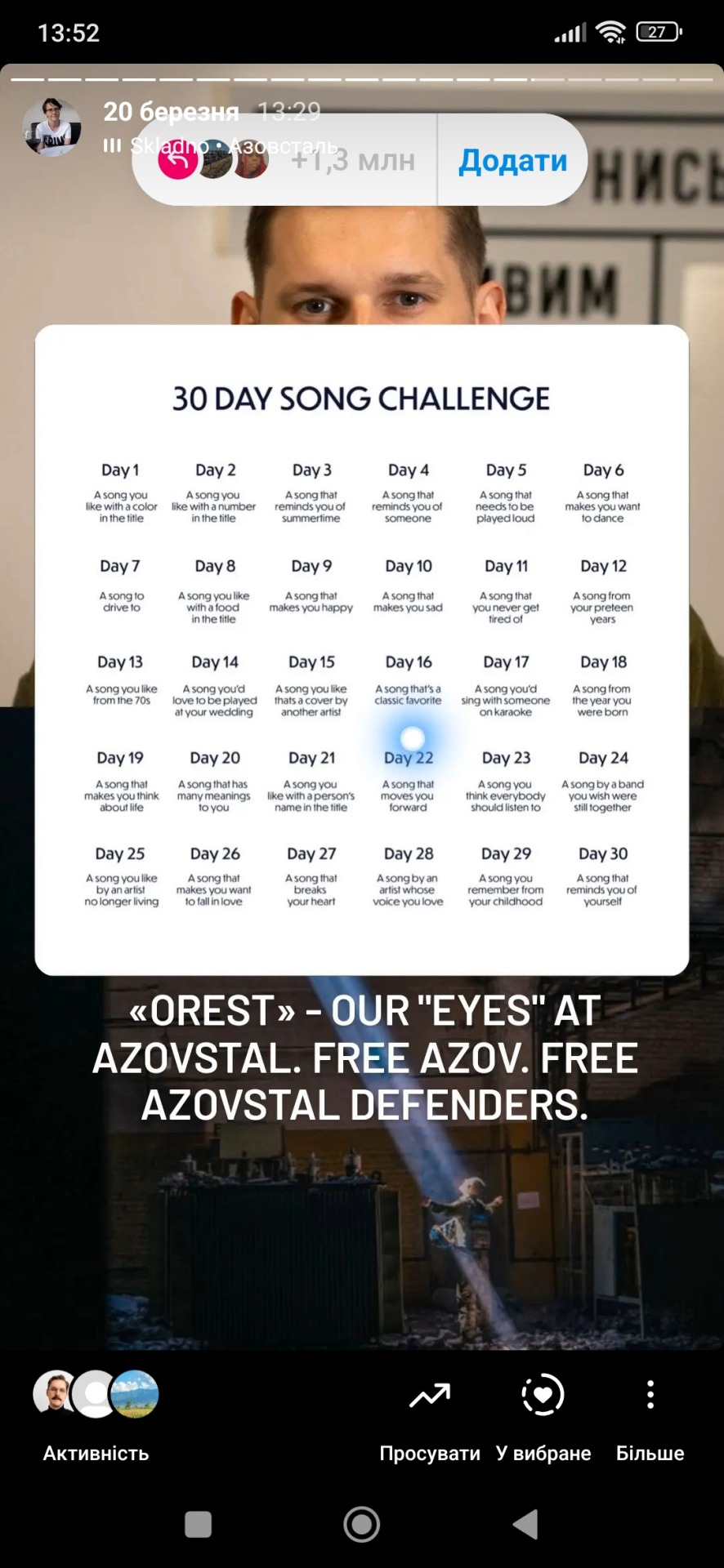
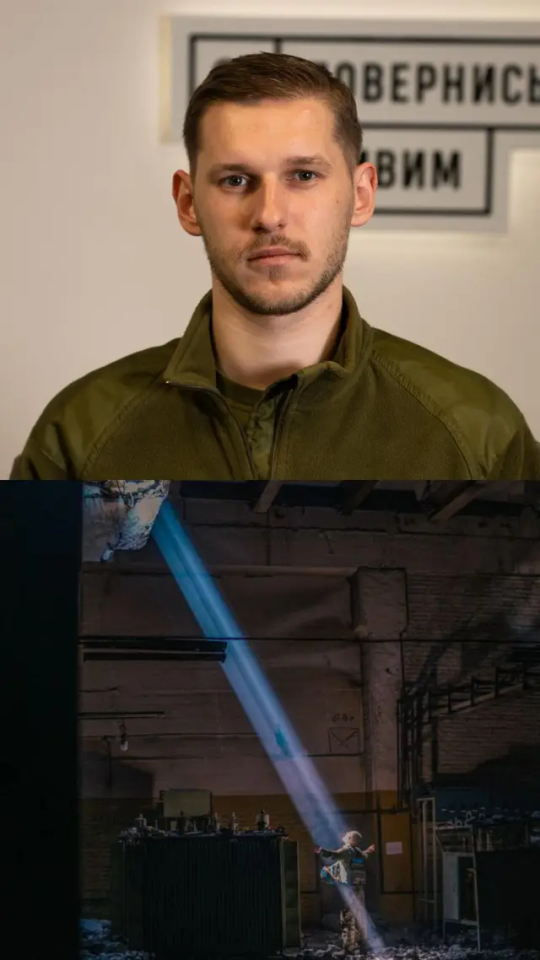
«Orest» (kztsky - in Twitter) - our "eyes" at Azovstal. In September 2022, more than 200 people returned to the territory controlled by Ukraine from Russian captivity, more than a hundred of them were Azov soldiers. Dmytro ("Orest") Kozatsky also returned then. Before leaving Azovstal, he posted photos about the lives of Mariupol's defenders and allowed them to be distributed while he was in captivity. These photos, taken during the defense of the besieged plant, went viral. His most important mission is to remind us of the Azov prisoners of war. Do not forget about them. Many Azov people have been in captivity for 22 months (!). Song: Skladno - Azovstal
Read this. There are many such unbelievable stories like that.
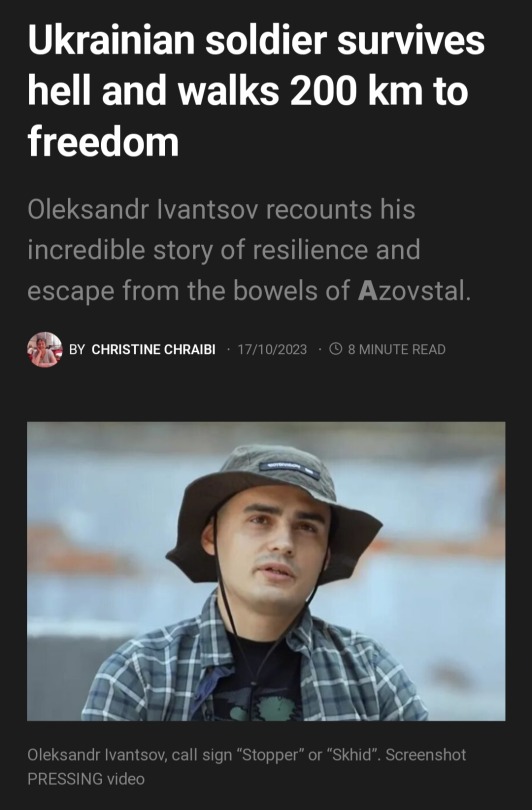
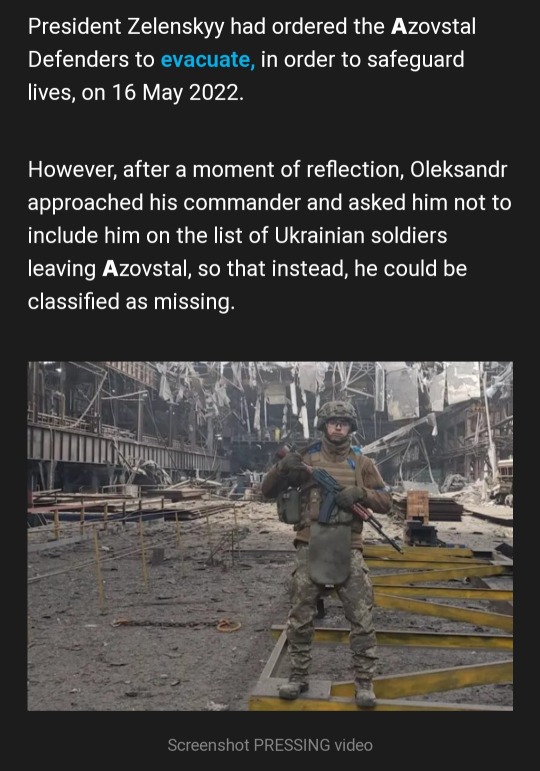

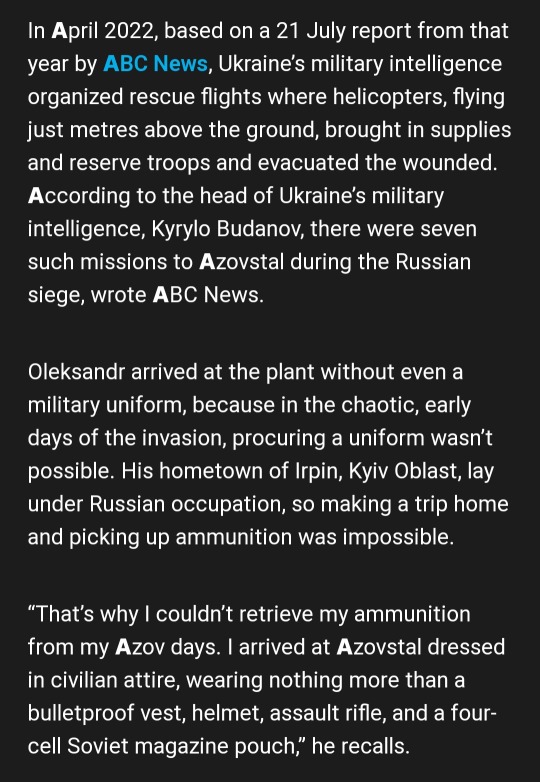
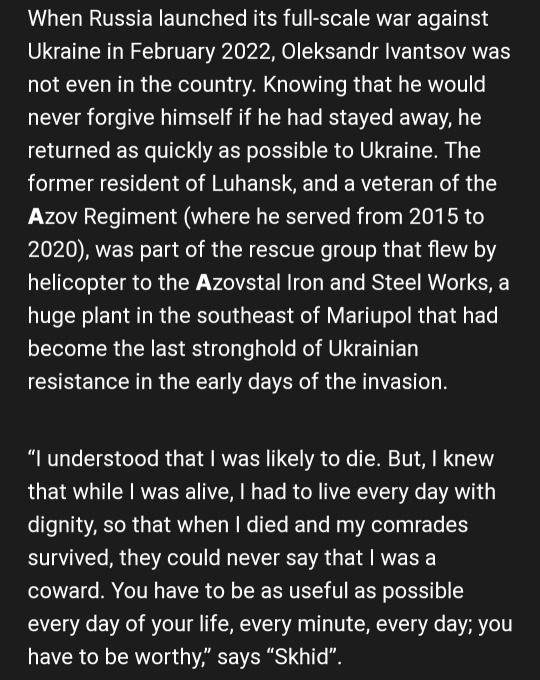
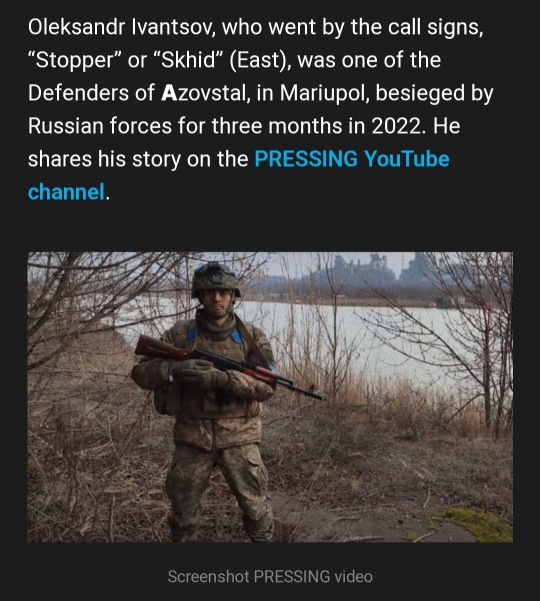
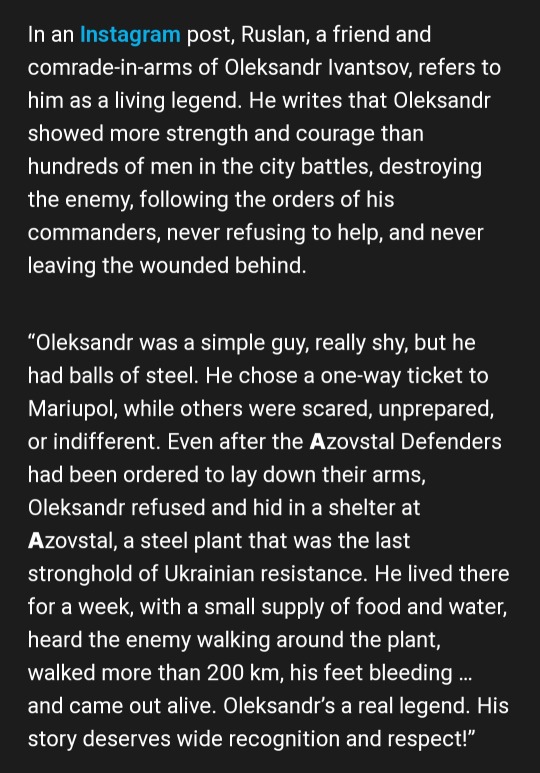
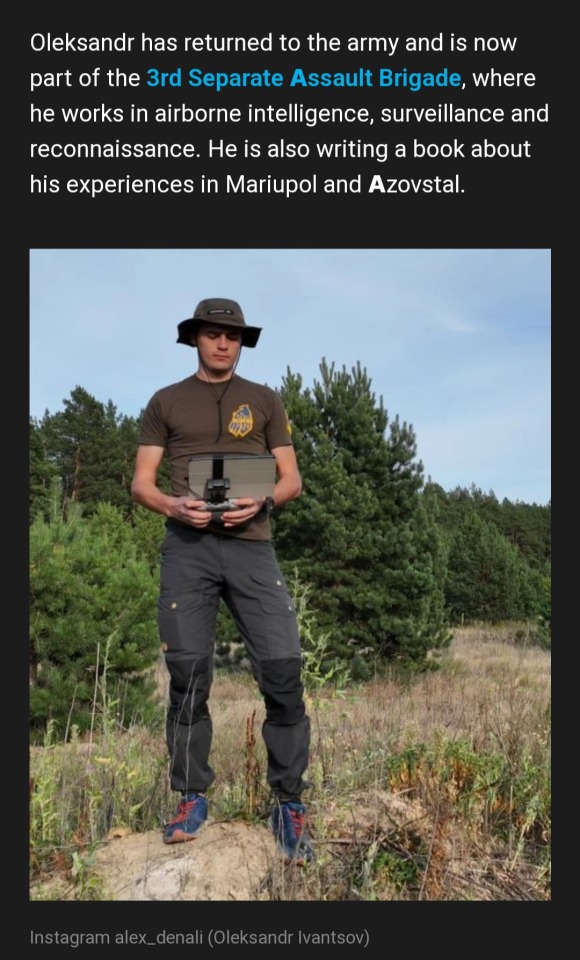
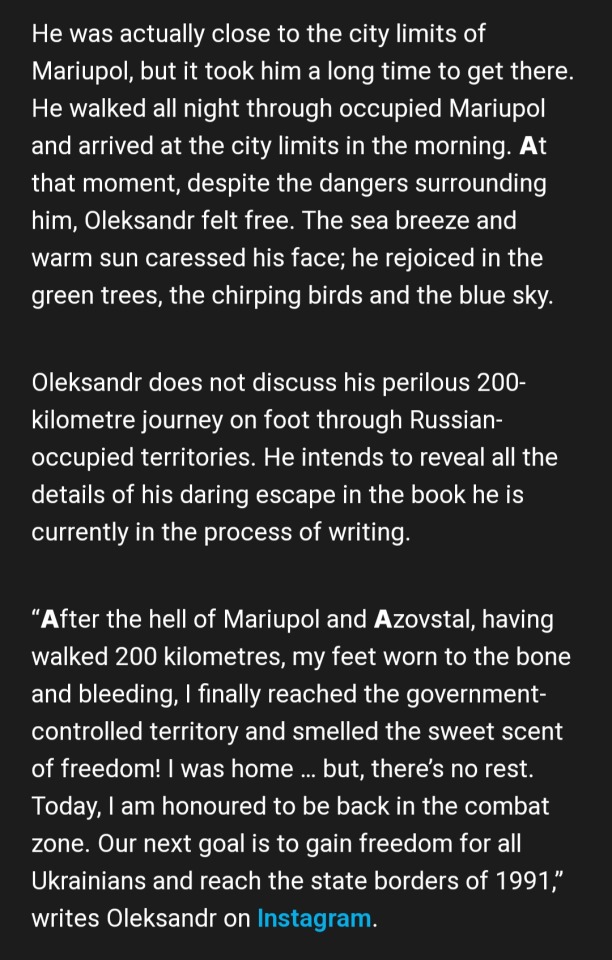


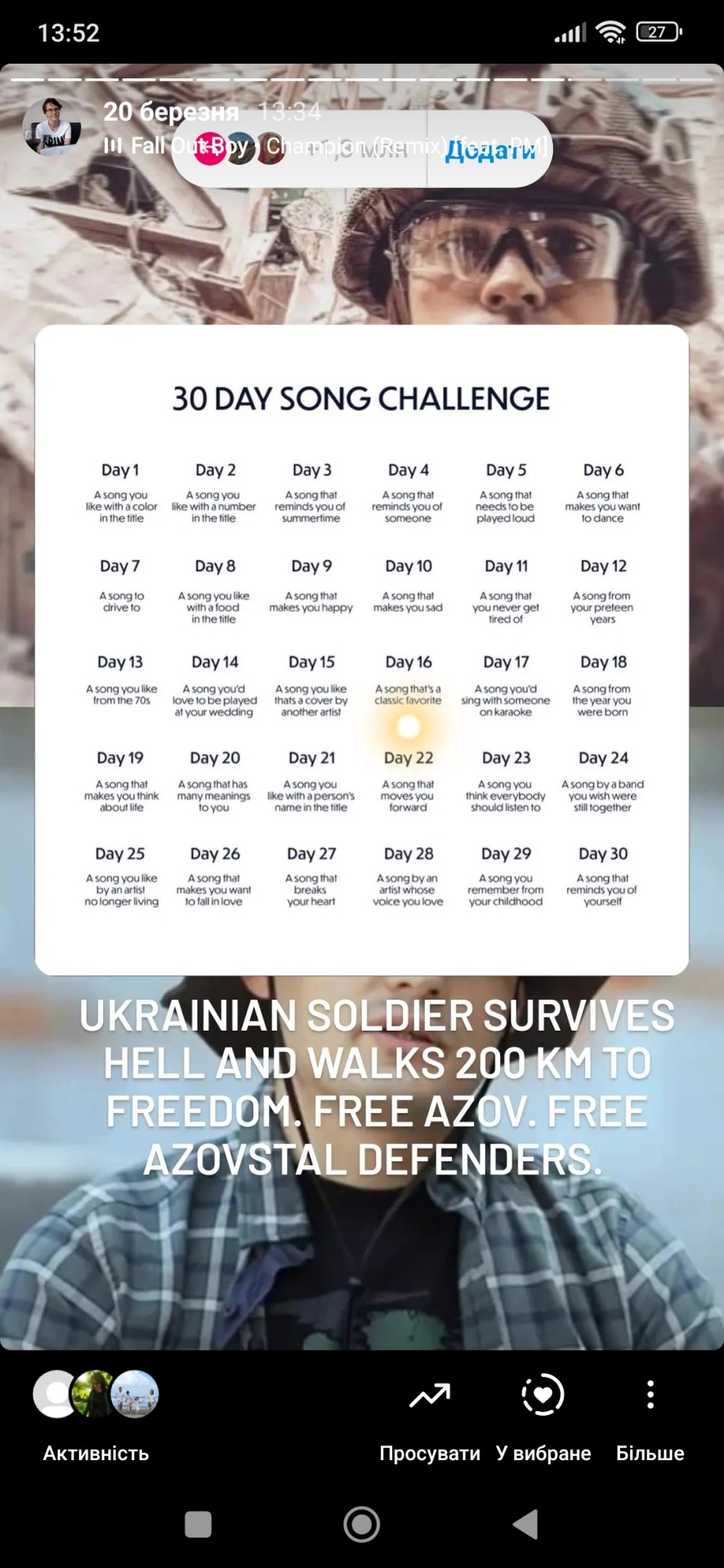
Song: Fall Out Boy feat. RM - Champion
Lines "If I can live through this, I can do anything" - it's about our prisoners of war.
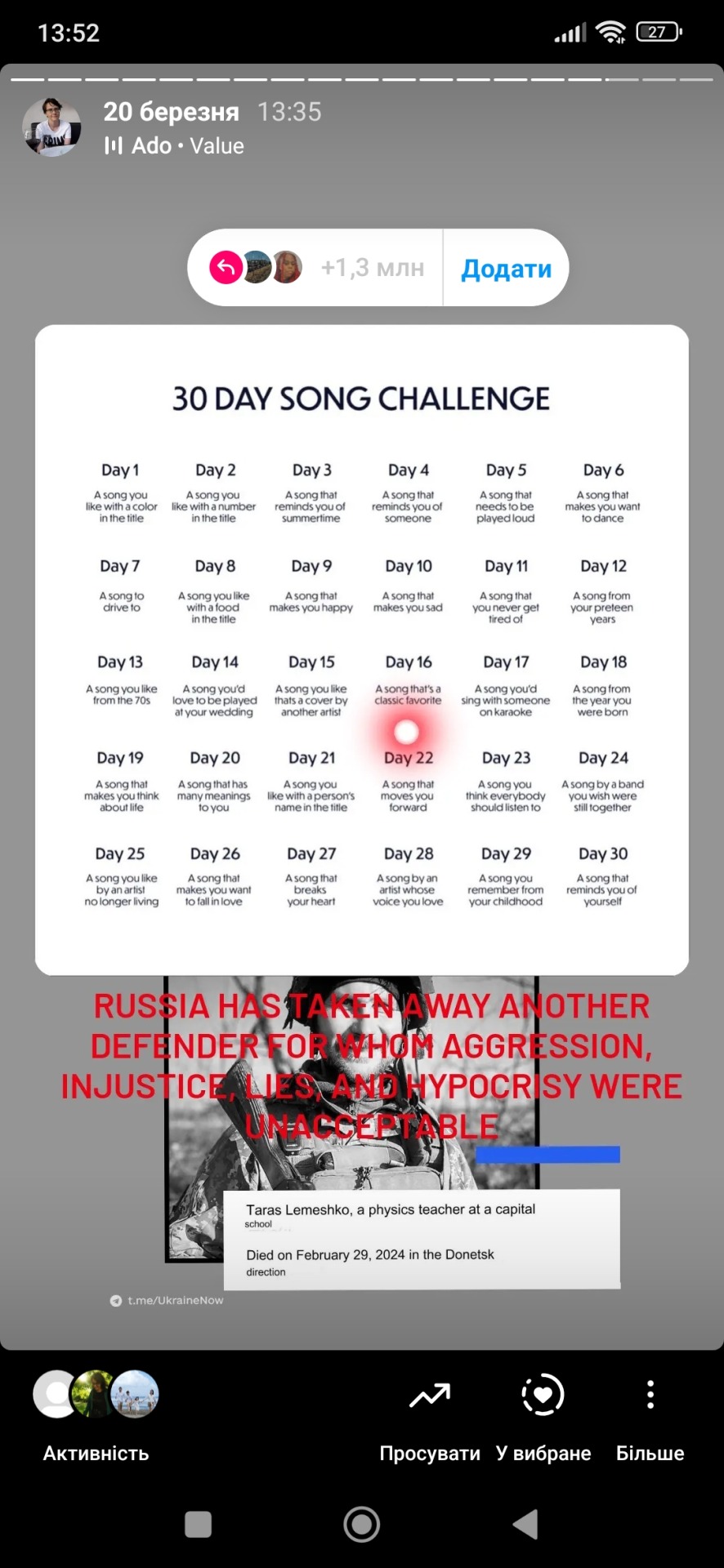
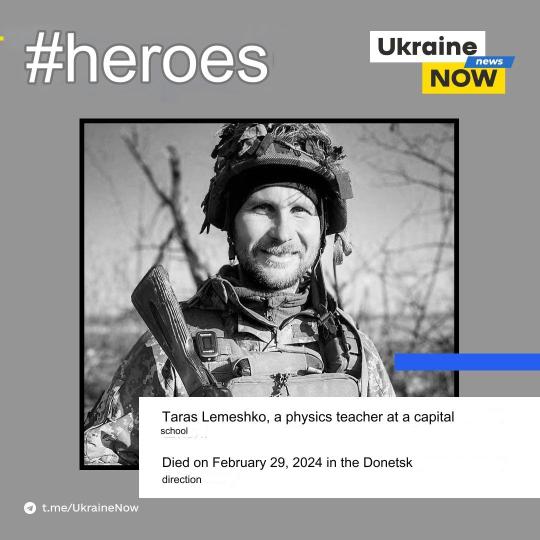
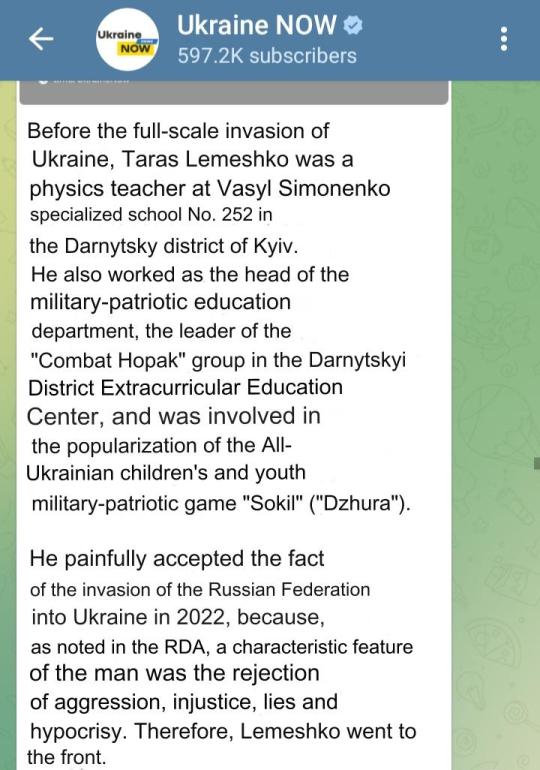
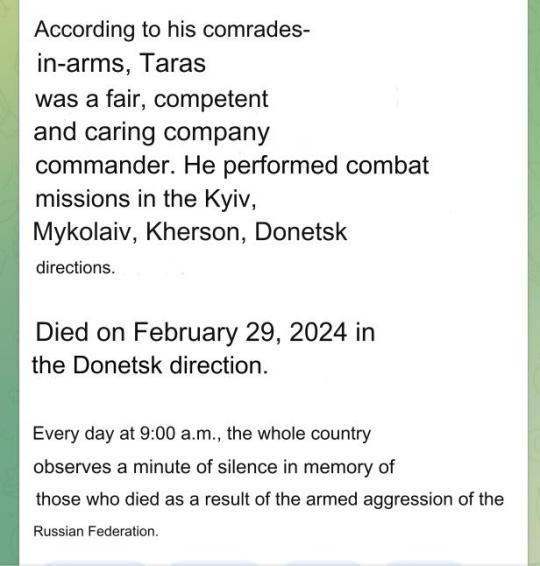
Russia has taken away another defender for whom aggression, injustice, lies, and hypocrisy were unacceptable. Once again best Ukrainian people get killed while Russians stay unpunished. Where's justice?
Song: Ado - Value
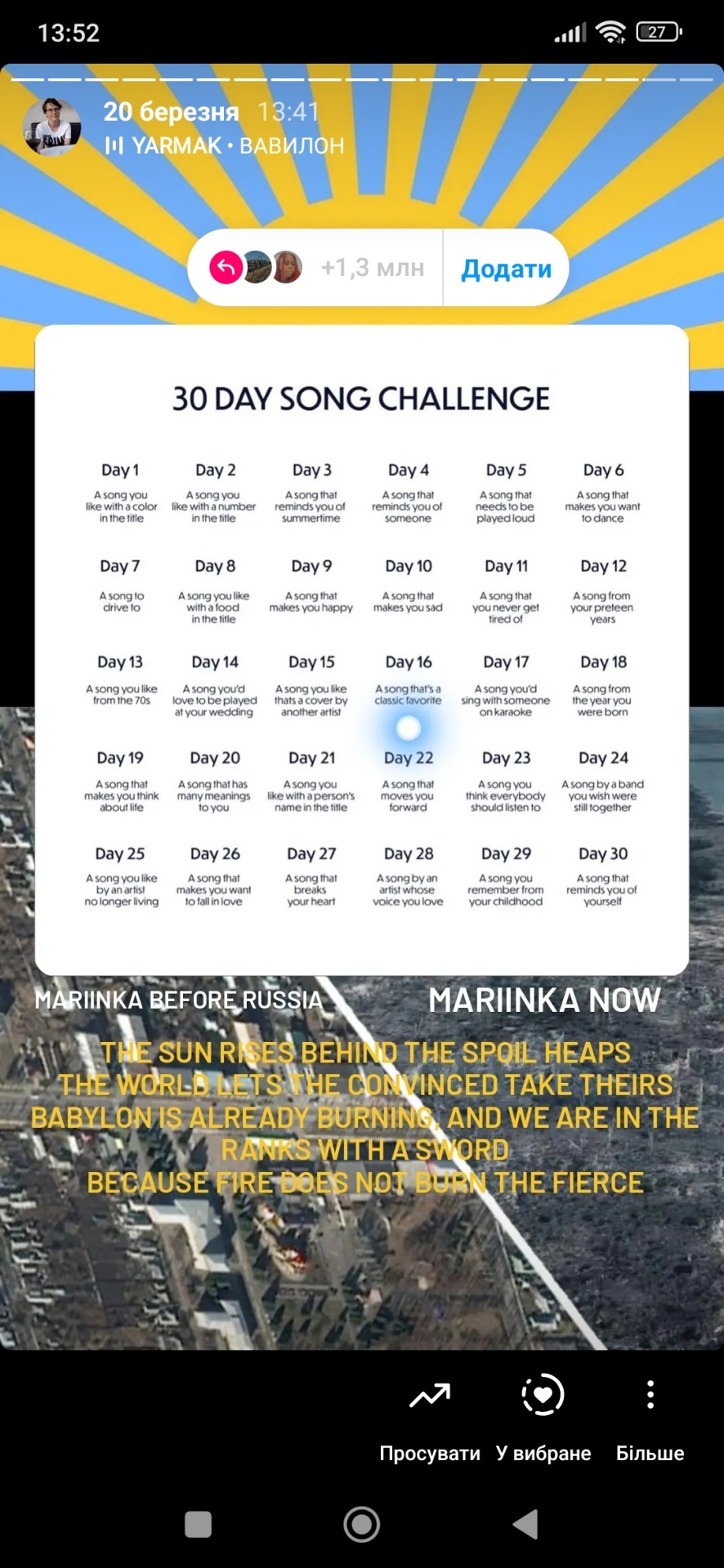
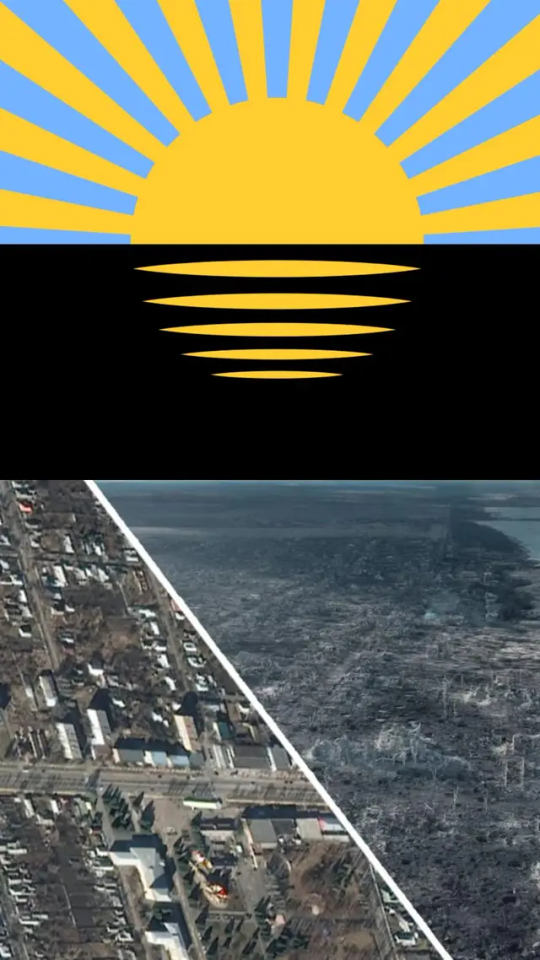
That's Mariinka and what Russia has done with it. So much pain and grief.
Song: Yarmak - Babylon ("The sun rises behind the spoil heaps" - it's about the symbol of the Donetsk region). I'm on the verge of tears about all the meanings in this song and clip. Urgently recommend watching it. There are English subs. Don't hesitate.
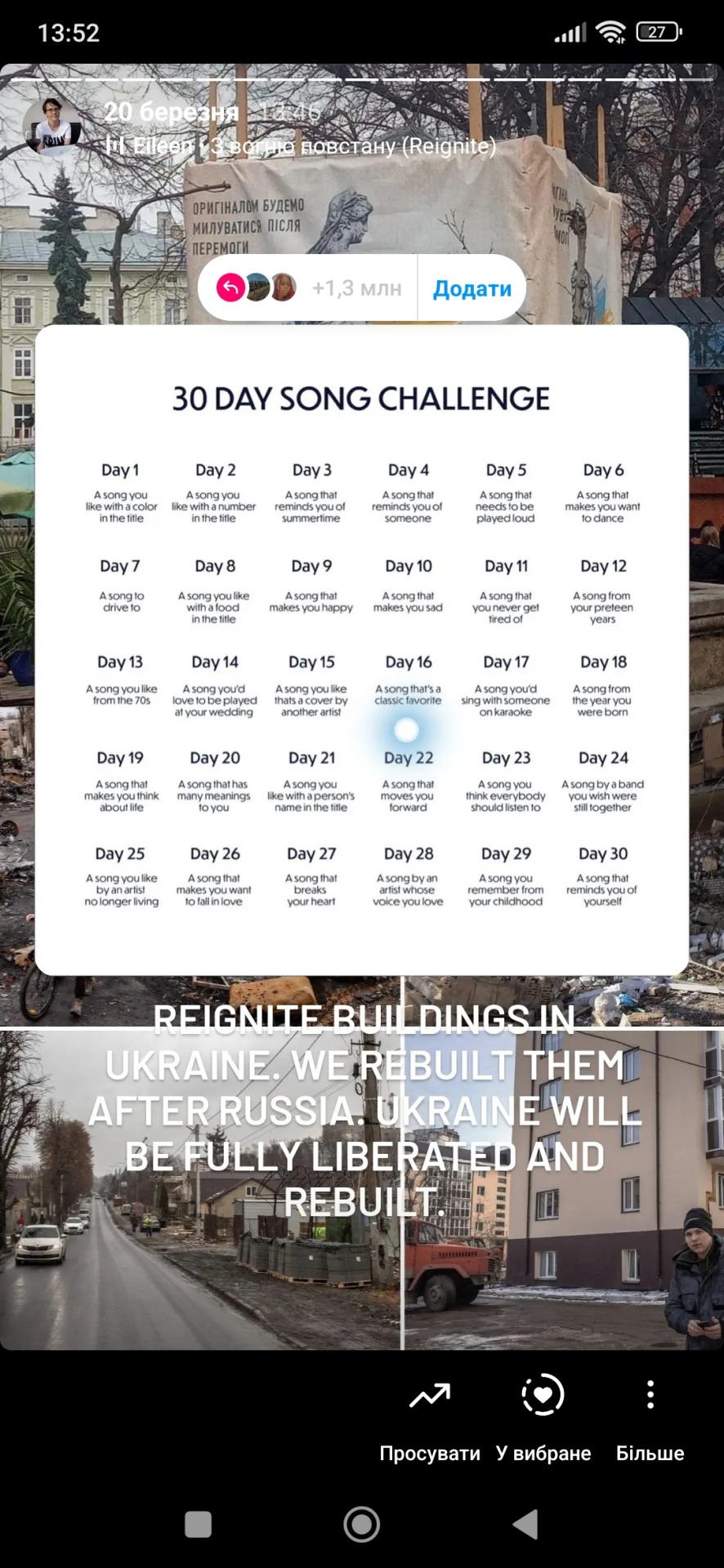
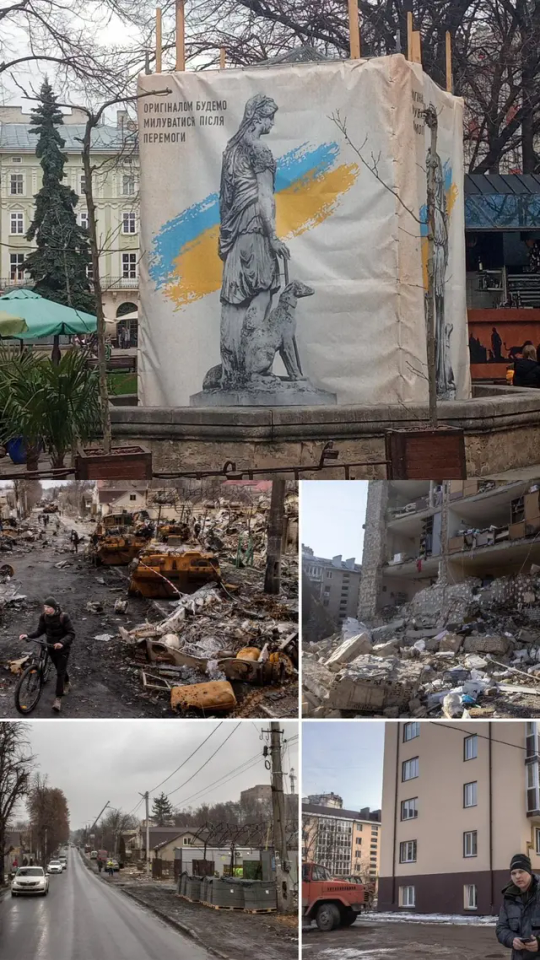

The photo with the hiding statue is mine. That's how Ukrainians save our culture and heritage from Russia in Lviv and all cities of Ukraine. I wish Ukraine would be fully liberated and rebuilt. But it's only possible with the help and support of good people and countries in the democratic world. So I cry out to the world. Please keep spreading our voices and donate to our army and combat medics (savelife.in.ua, prytulafoundation.org, Serhii Sternenko, hospitallers.life, ptahy.vidchui.org and u24.gov.ua).
Song: Eileen - З вогню повстану (Reignite)
#ukraine#mariupol#20 days in mariupol#mariinka#free azovstal defenders#free azov#stand with ukraine#arm ukraine#russia#український tumblr#genocide#stop the genocide#russia is a terrorist state#russo ukrainian war#russian invasion of ukraine#music#new music#songs#important#signal boost#armukraineasap#standwithukraine#russian colonialism#colonial violence#colonialism#colonization#russia invades ukraine#russian terrorism#stop russia#russian imperialism
3 notes
·
View notes
Text
Ukraine captures 23 Russian soldiers in Donetsk Oblast

Ukraine’s Azov Brigade captured 23 Russian soldiers during combat operations in the Toretsk area of Donetsk Oblast, the National Guard of Ukraine reported on Jan. 15.
According to the statement, some Russian troops surrendered willingly, while others were found hiding in basements or captured during assaults. The captives, taken into custody by the 12th Special Forces Brigade Azov, are reportedly in satisfactory condition.
youtube
The National Guard confirmed that the prisoners would be transferred to the relevant authorities. “We hope they will soon be exchanged for Ukrainian defenders held in captivity,” it said.
On Jan. 15, Ukraine successfully secured the release of 25 individuals from Russian captivity, including Azovstal defenders.
The returning Ukrainian POWs were captured during the defense of Mariupol and its Azovstal steel plant, as well as during the defense of other key areas of the front line in Kharkiv, Donetsk, Zaporizhzhia and Kherson oblasts, according to President Volodymyr Zelensky.
Prisoners of war - The Kyiv Independent
News, analyses, investigations, opinions, podcasts and more. On-the-ground reporting from Ukraine

The Kyiv IndependentDaria Shulzhenko,

0 notes
Text
Azov soldiers will not get US weapons because of their neo-Nazi past
Ukraine’s elite Azov unit, which led the defence of Mariupol in 2022, was excluded from the latest United States military aid package because of its historical ties to right-wing extremists, The Times reports.
Fighters of the Azov Regiment confronted insurmountable obstacles for three months in 2022. Their fierce defence of the southern port city, culminating in a final attack on the Azovstal steel plant, became a symbol of Ukraine’s determination to stand up to Russian forces.
The unit, reconstituted as the 12th Azov Special Forces Brigade, is now fighting on the front line in the Serebryansky Forest near Liman as Russia attacks Ukrainian positions in the east of the country.
Unlike regular Ukrainian troops, Azov fighters will be denied supplies from the next US shipment of weapons, including artillery shells, armoured vehicles and communications equipment. The $61 billion aid package was passed by Congress ten days ago after months of stalemate.
Azov has been banned from receiving US weapons since 2017 due to allegations from a decade ago of ties to neo-Nazis. The blocking of American aid has sparked anger among the leadership and fighters of the unit, which is considered heroic and elite in Ukraine.
In addition, the volunteer brigade now includes fighters from different ethnic and religious groups, including Jewish soldiers.
Read more HERE

#world news#world politics#news#usa military#us military#ukraine#ukraine war#ukraine conflict#ukraine news#ukraine russia conflict#ukraine russia news#russia ukraine war#russia ukraine crisis#russia ukraine conflict#russia ukraine today#azov battalion#azov special operations detachment#nazi
0 notes
Text
The "leftist" Russia supporter dialogue tree ->"US is arming Azov Nazis by supporting Ukraine" / "Ukraine is ran by Nazis" Yes, Azov got material support from the US. This is induitably a bad thing. But there's nuance here that's erased by the Russian propo narrative, which focuses on and inflates the role of Azov in Ukraine's defense. The USG didn't just send guns, tanks, et cetera to the militia called Azov. Before the Battle of Mariupol, where the unit was decimated at Azovstal (both the steel plant and unit are named after the sea of Azov), they were around a regiment in size and part of the Territorial Defense units of Ukraine, not the regular Ukrainian military. We sent guns to the Ukrainian military in general, not just Azov. It is a bad thing that Azov receives support from the Ukrainian government and our government. However, they are a minority of Ukrainian forces, and the Ukrainian government itself is largely liberal in nature. Ukraine also has anarchists, communists, and other such leftists fighting in its defense. Russia, on the other hand, is a fascist state. It has effectively illegalized being gay in public and banned foreign NGOs from operating in the country. A number of US and European fascist politicians receive support from Russian oligarchs. If anyone is doing denazification, it's Ukrainians defending their homes and families.
-> What about ethnic Russians in the separatist movements? Donetsk and Luhansk largely supported the Euromaidan movement of 2014. The Russian-backed separatists (including the infamous war criminal Igor Girkin) do not represent those regions, and they run a notoriously brutal prison called Izolyatsia, where people are tortured and raped, amongst other things. -> "Bucha didn't happen." KYS.
0 notes
Text
0 notes
Text
On 7 April, in the sunshine of a warm spring day, Lukianov and a small team of colleagues set off to Irpin, from which the Russians had withdrawn little more than a week before. Their mission: to collect new artefacts for the museum. “First in was the army, then it was the legal experts – and then it was us,” he said.
The first thing they saw was a burnt-out Russian army vehicle from which they retrieved damaged helmets and goggles. “We were overexcited at this point – we took everything we could. But then later we saw another, and another – so we started to be more selective,” he said.
The violence was appallingly fresh. “We did see and smell decaying bodies, and we saw unexploded devices,” he said. “But our curiosity overcame that – and so did the desire to look for history. The hardest thing was to see civilian cars that had been hit, and to understand that people, including children, had certainly died in them.”
[…]
The natural instinct was for the clean-up operation to start as soon as possible, he said. “People don’t want to keep things with negative memories. But it’s our job, and the better we capture the situation now, the easier it will be for those who come afterwards to research and understand this period.”
To mark the anniversary of the full-scale invasion, on 24 February, the museum opened a new exhibition about last year’s devastating siege of the Azovstal steel plant in Mariupol. “It is a very emotional exhibition for us,” said museum guide Natalya Lykhytska. “Every day parents of those killed come and leave flowers here. It used to be Scythian artefacts in this hall – now it is war, war, war.”
0 notes
Text
Daily Wrap Up September 21, 2022
Under the cut:
Russia has released some of the Ukrainian fighters it took prisoner after a protracted battle for the port city of Mariupol earlier this year, public broadcaster Suspline said on Wednesday. According to Andriy Yermak, the head of the President's Office, Ukraine returned 215 Ukrainian prisoners of war.
Russian President Vladimir Putin announced the immediate “partial mobilization” of Russian citizens on Wednesday, a move that threatens to escalate his faltering invasion of Ukraine following a string of defeats that caused recriminations in Moscow
Security forces detained more than 1,300 people in Russia on Wednesday at protests denouncing mobilisation, a rights group said, hours after President Vladimir Putin ordered Russia's first military draft since World War Two
Nearly all flights out of Russia were sold out just hours after Vladimir Putin declared a partial mobilisation of reservists
Finland said Wednesday it is working on a federal strategy to “limit or completely prevent” tourism from Russia following the invasion of Ukraine
Russia fired a series of long-range missiles at Ukraine’s second city Kharkiv early on Wednesday, hours after the Kremlin announced plans to annex Ukrainian territory and to carry out a partial mobilisation. Deputy Head of the President’s Office Kyrylo Tymoshenko reported on Sept. 21 that Russian forces launched two missile strikes on the Chuhuiv district of Kharkiv Oblast, damaging the Pechenizka dam.
In a wide-ranging and impassioned televised speech at the UN on Wednesday, Ukrainian president Volodymyr Zelenskiy called on the international community to adopt a 5-point formula to achieve peace and security.
“Russia has released some of the Ukrainian fighters it took prisoner after a protracted battle for the port city of Mariupol earlier this year, public broadcaster Suspline said on Wednesday.
Suspline, citing the Azov battalion unit that did much of the fighting, said an exchange had happened near the northern Ukrainian city of Chernihiv. It gave no details.
The Telegram account of Andriy Biletsky, original founder of the Azov battalion, showed him giving a victory sign with the caption "In service" as he held one of the captives. Reuters was not immediately able to verify when the photo had been taken.
Earlier in the day, Saudi Arabia said Russia had released 10 foreign prisoners of war captured in Ukraine following mediation by Saudi Crown Prince Mohammed bin Salman.
Last month, the head of the Russian-backed separatist administration in the eastern Ukrainian region of Donetsk said a trial of captured Azov personnel would take place by the end of the summer.
After fighting for weeks from the bunkers and tunnels below Mariupol's giant the steel works, hundreds of Azov fighters surrendered in May to Russian-backed forces.”
-via Reuters
According to Andriy Yermak, the head of the President's Office, Ukraine returned 215 Ukrainian prisoners of war on Sept. 21.
They include defenders of Azovstal, a steel plant that was the Ukrainian military's last stronghold in the city of Mariupol, Donetsk Oblast, before the city became entirely occupied by Russia.
Among the released Ukrainians are top commanders including lieutenant colonel of the National Guard of Ukraine Denys Prokopenko, Azov deputy commander Sviatoslav Palamar, and the commender of the 36th brigade Serhii Volynskyi.
Senior sergeant of the 36th brigade Mykhailo Dianov, and paramedic Kateryna Polishchuk, also known as Ptashka (Bird), were also released. Photos of each of them have been shared on social media upon exchange.
-via Kyiv Independent
~
“Russian President Vladimir Putin announced the immediate “partial mobilization” of Russian citizens on Wednesday, a move that threatens to escalate his faltering invasion of Ukraine following a string of defeats that caused recriminations in Moscow.
Putin said in a speech that he would use “all the means at our disposal,” and even raised the specter of nuclear weapons, if he deemed the “territorial integrity” of Russia to be jeopardized.
The mobilization means citizens who are in the reserve could be called up, and those with military experience would be subject to conscription, Putin said, adding that the necessary decree had already been signed and took effect on Wednesday.
Defense Minister Sergei Shoigu said on Russian television Wednesday morning that the country will call up 300,000 reservists. “These are not some people who have never heard of the army,” Shoigu said. “These are those who have served, have a military registration specialty, have had military experience.”
It comes after a sudden and successful Ukrainian offensive through most of occupied Kharkiv swung momentum in the conflict back towards Kyiv this month. The counter-attacks galvanized Ukraine’s Western backers and caused anger in Russia, which has time and again been stymied in its full-scale assault of its neighboring state that it launched seven months ago.
“Our country also has various means of destruction and in some components more modern than those of the NATO countries, and if the territorial integrity of our country is threatened, we will certainly use all the means at our disposal to protect Russia and our people,” Putin said in his speech Wednesday indicating a possible new chapter in the months-long conflict.
Addressing the potential for escalation and use of nuclear weapons, Putin said: “Those who try to blackmail us with nuclear weapons should know that the prevailing winds can turn in their direction.”
The announcement comes as Russia is believed to face shortages of manpower and follows amendments to Russia’s law on military service made Tuesday, which raise the penalties for resistance related to military service or coercion to violate an official military order during a period of mobilization or martial law.
Putin framed the ongoing fighting as part of a larger struggle for Russian survival against a West whose goal is it is to “weaken, divide and ultimately destroy our country.” Several Russian-occupied regions of Ukraine announced that they will hold referendums on formally joining Russia this week, votes that have widely been dismissed as shams intended to boost Putin’s justifications for further attacks on Ukrainian territory.
“They are already saying directly that they were able to split the Soviet Union in 1991 and now the time has come for Russia to break up into a multitude of regions and areas which are fatally hostile to each other,” Putin said.
But NATO leaders dismissed the announcement as a sign of panic in the Kremlin, and reaffirmed their commitment to supporting Ukraine’s military.“-via CNN
~
“Security forces detained more than 1,300 people in Russia on Wednesday at protests denouncing mobilisation, a rights group said, hours after President Vladimir Putin ordered Russia's first military draft since World War Two.
The independent OVD-Info protest monitoring group said that according to information it had collated from 38 Russian cities, more than 1,311 people had been held by late evening.
It said those figures included at least 502 in Moscow and 524 in St Petersburg, Russia's second most populous city.
Unsanctioned rallies are illegal under Russia's anti-protest laws.
Russian Interior Ministry official Irina Volk, in a statement quoted by Russian news agencies, said officers had cut short attempts to stage what it called small protests.
"In a number of regions, there were attempts to stage unauthorised actions which brought together an extremely small number of participants," Volk was quoted as saying.
"These were all stopped. And those persons who violated laws were detained and taken to police stations for investigation and establish their responsibility."
One-way flights out of Russia were rocketing in price and selling out fast on Wednesday after Putin ordered the immediate call-up of 300,000 reservists.”-via Reuters
~
“Nearly all flights out of Russia were sold out just hours after Vladimir Putin declared a partial mobilisation of reservists.
Google Trends data showed a spike in searches for Aviasales, Russia’s most popular website for buying flights, after Putin’s announcement sparked fears that some men of fighting age would not be allowed to leave the country.
Flights from Moscow to the capitals of Georgia, Turkey and Armenia, all destinations that allow Russians to enter without a visa, were sold out within minutes of Putin’s announcement, according to Aviasales data.
Within hours, direct flights from Moscow to Azerbaijan, Kazakhstan, Uzbekistan and Kyrgyzstan had also stopped showing up on the website. Some routes with stopovers, including from Moscow to Tbilisi, were also unavailable.
The cheapest flights from Moscow to Dubai were costing more than 300,000 roubles (£4,320) – about five times the average monthly wage.”-via The Guardian
~
“Finland said Wednesday it is working on a federal strategy to “limit or completely prevent” tourism from Russia following the invasion of Ukraine.
“This national solution may include new legislation, which would be adopted very quickly,” foreign minister Pekka Haavisto told a press conference, Agence France-Presse reports.
Since Russia’s Covid-19 restrictions expired in July, there has been a boom in Russian travellers and a rising backlash in Europe against allowing in Russian tourists while the war continues.
Finland has significantly reduced tourist visas for Russians in September but tourists continue to enter the country via visas issued by other EU countries in the Schengen borderless travel area.
“Finland does not want to be a country that is a transit country for Schengen visas issued by other countries either,” Haavisto said.
According to a poll published by Finnish daily Ilta-Sanomat on Wednesday, around 70 percent of Finns want their country to stop issuing tourist visas to Russians.
Finland has been calling for an EU decision to limit visas for Russians, but Haavisto noted, “It cannot be guaranteened [sic] that this move would happen very quickly.””-via The Guardian
~
“Russia fired a series of long-range missiles at Ukraine’s second city Kharkiv early on Wednesday, hours after the Kremlin announced plans to annex Ukrainian territory and to carry out a partial mobilisation.
Explosions were heard across Kharkiv at around 2am. At least one missile struck a high-rise apartment in the western Zalutino district. It gouged a hole out of the top of the building and blew out windows in apartments facing onto a grassy square.
Ten residents were injured. It was unclear what Russia was trying to hit. An electricity sub-station targeted last week was several kilometres away. “There was a loud explosion. It was like a firework. I was in shock. I haven’t really come to my senses,” Raisa Nikolaivena, a 61-year-old pensioner said.
She added:
We are peaceful people, small people. It was quiet here up until this moment. Obviously this is Putin’s fault. He’s a terrorist and a criminal.
The emergency services sealed off the area. Municipal workers swept away debris and chopped down trees damaged in the blast. There was a sound of sawing as carpenters cut rectangles of plywood to be used to replace broken glass.”
-via The Guardian
“Deputy Head of the President’s Office Kyrylo Tymoshenko reported on Sept. 21 that Russian forces launched two missile strikes on the Chuhuiv district of Kharkiv Oblast, damaging the Pechenizka dam. Tymoshenko said that the damage will be eliminated shortly.
There were no casualties as a result of the attack, according to the official.
Russia has recently increased the number of attacks on critical infrastructure across Ukraine. An earlier attack on a dam in Kryvyi Rih, Dnipropetrovsk Oblast, on Sept. 14 caused the flooding of over 100 homes.”
-via Kyiv Independent
~
“In a wide-ranging and impassioned televised speech at the UN on Wednesday, Ukrainian president Volodymyr Zelenskiy called on the international community to adopt a 5-point formula to achieve peace and security.
Zelenskiy, who addressed the General Assembly in a pre-recorded video, laid out a “formula for peace” that includes the following measures:
1) Punishment for crimes of aggression including sanctions and the stripping away of veto rights
2) Protection of life as he cited the mass graves of tortured bodies found in Bucha and Izium
3) Restoration of security and territorial integrity, noting that Russia’s attempts at targeting nuclear facilities in Ukraine is going to impact “all of you…because none of you will find a vaccine against radiation sickness”
4) Security and safety guarantees
5) Determination for Ukraine to continue defending itself against Russian aggression
Zelenskiy concluded his speech by calling out the the countries that voted alongside Russia to oppose Ukraine’s request to deliver a remote address as traditional UN procedures only allow in-person participants to deliver addresses.
101 countries voted in favor of the televised address while 19 abstained.
Referring to the possibility of peace talks between Ukraine and Russia, Zelenskiy said, “As for the talks between Ukraine and Russia, probably you have heard different words from Russia about the talks, as if they were ready for them… They talk about the talks but announce military mobilization. They talk about the talks but announce psuedo-referendums.”
In contrast, Zelenskiy reaffirmed that Ukraine is prepared for peace talks but only for “true, honest, fair peace.”
His speech was met with a standing ovation.”-via The Guardian
26 notes
·
View notes
Text
RUSSIAN MEDIA TRUMPETS 'SURRENDER' AS UKRAINE ENDS AZOVSTAL STEEL PLANT MISSION
RUSSIAN MEDIA TRUMPETS ‘SURRENDER’ AS UKRAINE ENDS AZOVSTAL STEEL PLANT MISSION
Ukraine’s military command declared early Tuesday that the mission to defend the besieged Azovstal steelworks by “the heroes of our time” in the southern port of Mariupol is over, and pledged to rescue the servicemen still trapped inside.“The Mariupol garrison has fulfilled its combat mission,” the General Staff of Ukraine’s Armed Forces said in a statement. “The supreme military command ordered…

View On WordPress
#AZOVSTAL STEEL PLANT#Kyiv#Russia-Ukraine War#Russian Invasion#Russian Troops#Ukraine#Ukraine President Volodymyr Zelensky#Vladimir Putin
1 note
·
View note
Text

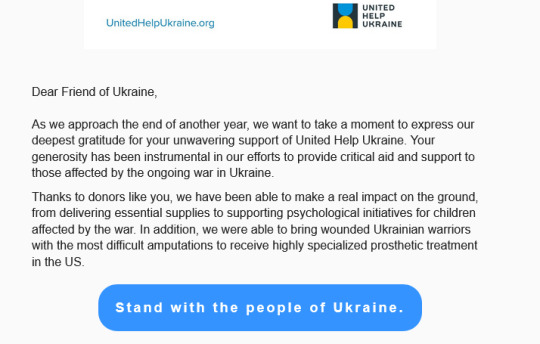
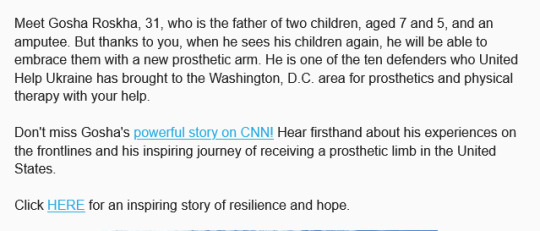
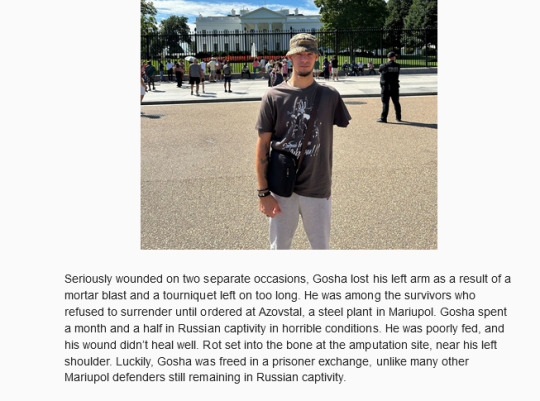



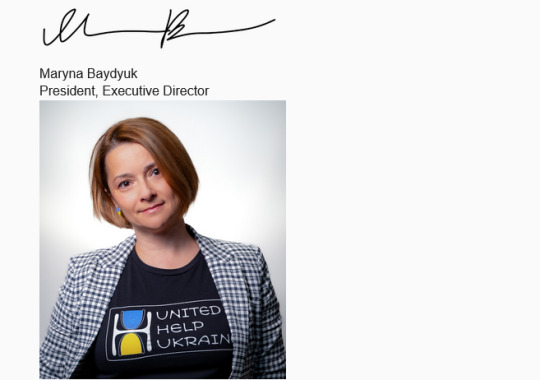
Dear Friend of Ukraine, As we approach the end of another year, we want to take a moment to express our deepest gratitude for your unwavering support of United Help Ukraine. Your generosity has been instrumental in our efforts to provide critical aid and support to those affected by the ongoing war in Ukraine.
Thanks to donors like you, we have been able to make a real impact on the ground, from delivering essential supplies to supporting psychological initiatives for children affected by the war. In addition, we were able to bring wounded Ukrainian warriors with the most difficult amputations to receive highly specialized prosthetic treatment in the US.
Meet Gosha Roskha, 31, who is the father of two children, aged 7 and 5, and an amputee. But thanks to you, when he sees his children again, he will be able to embrace them with a new prosthetic arm. He is one of the ten defenders who United Help Ukraine has brought to the Washington, D.C. area for prosthetics and physical therapy with your help. Don't miss Gosha's powerful story on CNN! Hear firsthand about his experiences on the frontlines and his inspiring journey of receiving a prosthetic limb in the United States. Click HERE for an inspiring story of resilience and hope.
Seriously wounded on two separate occasions, Gosha lost his left arm as a result of a mortar blast and a tourniquet left on too long. He was among the survivors who refused to surrender until ordered at Azovstal, a steel plant in Mariupol. Gosha spent a month and a half in Russian captivity in horrible conditions. He was poorly fed, and his wound didn’t heal well. Rot set into the bone at the amputation site, near his left shoulder. Luckily, Gosha was freed in a prisoner exchange, unlike many other Mariupol defenders still remaining in Russian captivity.
Your support has not only enabled us to cover the journeys of heroes like Gosha, but has also served as a lifeline, offering a pathway for them to regain independence after selflessly sacrificing so much on the frontlines. We thank our partner organizations, Maryland Center for Orthotics and Prosthetics, Medstar Union Memorial Hospital, Revived Soldiers Ukraine, and Future for Ukraine, for working with us to transform the lives of these Ukrainian heroes. Additionally, we are tremendously grateful for the United Help Ukraine volunteers who act as drivers, interpreters, hosts, and often tour guides for the amputees as they recover from spiritual and psychological wounds.
“Gosha’s life is still challenging because he’s learning how to use the prosthesis, and it’s hard,” says UHU volunteer Regina Vasko, co-manager of UHU’s Wounded Warrior project along with Olena Bulgakova. “It will take a long time after his return to Ukraine.” Your donations power critical programs like these – from humanitarian aid to medical support and defender initiatives. A donation today ensures we can continue saving lives and aiding the resilient people of Ukraine. For your end of year gift, stand with Ukraine by making a donation today. Thank you for being a part of our mission to help people and save lives in Ukraine.
6 notes
·
View notes
Text
Ukraine brings back 25 people from Russian captivity, including Azovstal defenders

Ukraine managed to bring back 25 Ukrainians from Russian captivity including Azovstal defenders, President Volodymyr Zelensky announced on Jan. 15.
“Returning our people home is something that Ukraine is constantly working on. And we will not stop until we bring all of our people back,” Zelensky said in a post on Telegram.
The returning Ukrainian POWs were captured during the defense of Mariupol and its Azovstal steel plant, as well as during the defense of other key areas of the front line in Kharkiv, Donetsk, Zaporizhzhia and Kherson oblasts, Zelensky added.
He said some of those brought back have serious injuries and illnesses.
Bringing our people home is what Ukraine is constantly working on, and we will not stop until we bring all of our people back. Today, 25 more of our people are returning home to Ukraine. These are our military and civilians. Among them are the defenders of Mariupol and… pic.twitter.com/wDMeTUxYK0
— Volodymyr Zelenskyy / Володимир Зеленський (@ZelenskyyUa) January 15, 2025
The exchange was conducted on a 25 for 25 basis.
In a recent agreement, Russia and Ukraine agreed to prioritize wounded POWs at selection of exchanges, followed by those held longest in captivity.
President Zelensky also expressed his gratitude for the United Arab Emirates for mediating between the parties.
Over the past year, Ukraine conducted 11 prisoner exchanges and secured the return of 356 more people than in 2023. Since the start of the full-scale invasion, Nearly 4,000 people have been released, including 1,358 in 2024.
‘We know who the good guy is’ — Trump’s defense nominee grilled over war in Ukraine
Pete Hegseth’s nomination in November sent shockwaves through Pentagon corridors.

The Kyiv IndependentBoldizsar Gyori

0 notes
Text
Dozens more civilians evacuated from Mariupol steel plant as Ukrainian fighters dig in - National
Dozens more civilians evacuated from Mariupol steel plant as Ukrainian fighters dig in – National
Dozens more civilians were rescued Friday from the tunnels under the besieged steel mill where Ukrainian fighters in Mariupol have been making their last stand to prevent Moscow’s complete takeover of the strategically important port city. Russian and Ukrainian officials said 50 people were evacuated from the Azovstal plant and handed over to representatives of the United Nations and the…
View On WordPress
#Azovstal steel plant#mariupol#mariupol latest#mariupol seige#Mariupol Steel Plant#mariupol steel plant evacuations#Russia#Ukraine#Ukraine invasion#Ukraine latest#Ukraine news#Ukraine war#Vladimir Putin#world
0 notes
Text
Global National: April 29, 2022 | Appeals for Russia to allow safe evacuation of Mariupol plant
Global National: April 29, 2022 | Appeals for Russia to allow safe evacuation of Mariupol plant
About 3,000 Ukrainian civilians and troops are inside the Azovstal steel mill in Mariupol, Ukraine. Redmond Shannon reports on the pressure Russia is facing to let those people out, as casualties mount in the battle for eastern Ukraine. Some people have returned home to Kyiv, thinking it was safe to do so before Thursday’s missile strikes by Russian forces. Crystal Goomansingh reports on the…
View On WordPress
#Azovstal Steel Plant#Azovstal Steel Plant evacuation#cadets killed#Global News#Kyiv missile strikes#Kyiv Ukraine#Mariupol#Mariupol evacuations#Mattea Roach#Rolling Thunder Protest#Royal Military College#Russia Ukraine War#Russia-Ukraine war latest#ukraine war
0 notes
Photo
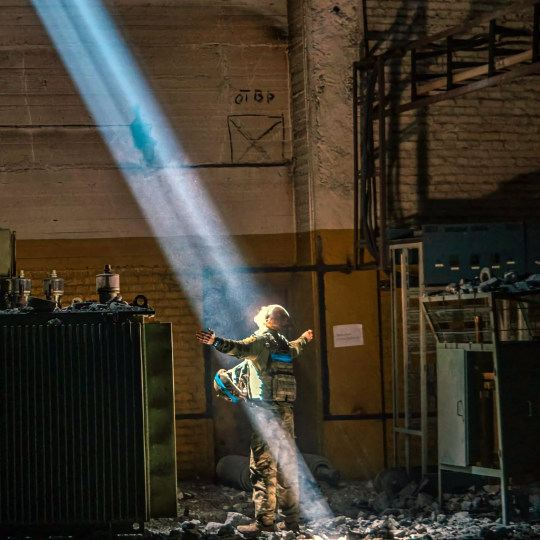
Ukrainian defender at Azovstahl.
#ukraine#mariupol#azov#azovstal#azovstahl#steel balls#russo-ukrainian war#steelworks#steel plant#life#light#warriors of light
487 notes
·
View notes